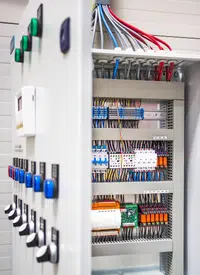

Electrical fires are one of the top causes of fires in industrial settings. In fact, the National Fire Protection Association (NFPA) found that fires caused by electrical distribution and lighting equipment accounted for 55% of direct property damage, as well as 9% of civilian injuries from 2011 to 2015. Electrical failure or malfunction caused $25 million dollars of direct property damage in the same time span.When a Class C fire occurs, it’s important to know which fire extinguisher or suppression system is appropriate. How do electrical fires start? How do you fight an electrical fire? Let’s dive into the answers.

Fire is categorized into five different types: A, B, C, D, and K. Each type of fire feeds on a specific fuel source and is dealt with using a specific type of fire extinguisher or fire suppression system. For example, Class A fires are the most common type of fire and come from materials like wood, paper, fabric, rubber, and plastic. Water and foam extinguishers are most often used to fight Class A fires. However, Class C fires are electrical fires and a specific fire suppression system is needed.
Class C fires use live electrical currents or electrical equipment as a source of fuel. A Class C fire can involve electrical tools, wiring, or appliances, and often occur in industrial settings. Keep in mind that Class C fires cannot be fought with water— using water as an extinguishing agent can actually make Class C fires worse! The most effective way to put out a Class C fire is to isolate the source of electricity and use a Class C fire extinguisher.
A Class C fire can start from a variety of ignition sources, like:

However, there are some places where Class C fires are more common. A Class C fire can start in an electrical cabinet. Control cabinets and relay panels have many electrical connections and ignition points. Faulty wiring or short circuits can cause an electrical panel to ignite and spread unless action is taken. The result can be devastating, causing injury to workers, damaged equipment, and lengthy (and costly) downtime.
Despite the fact that electrical panels have many potential ignition points, fire protection for electrical cabinets is not always a regulatory requirement.
As OSTİM Defense and Aerospace Cluster (OSSA), we held a cooperation meeting with the Ministry of National Defense General Directorate of Technical Services. The opening remarks were delivered by OSSA Chairman of the Board, Mr. İbrahim Yarsan; ASFAT General Manager, Prof. Dr. Mustafa İlbaş; and Major General Ercan Eroğlu, General Director of Technical Services at the Ministry of National Defense. Following the opening session, experts from the Ministry of National Defense delivered informative presentations on “Introduction to MoD Military Factories” and “MoD Facility Security Clearance / Production Permit Certificate Processes.” As Nero Industry, we had the opportunity to present our products and capabilities to the MoD delegation and engage in bilateral cooperation meetings throughout the program.
*Legal Notice and Intellectual Property Disclaimer:
The entire content of this website including but not limited to all textual content, graphics, logos, images, photographs, illustrations, technical and scientific drawings, audio and video clips, animations, audiovisual recordings, software, source code, databases, design elements, user interface components, and all other technical and creative materials, together with all associated intellectual and industrial property rights is the sole and exclusive property of NERO Industries Defense Inc. or its duly authorized licensors. Such content is protected under the applicable laws and regulations of the Republic of Turkey, including but not limited to the Law on Intellectual and Artistic Works (Law No. 5846), the Turkish Commercial Code, the Turkish Penal Code, as well as all relevant international treaties and conventions to which the Republic of Turkey is a party, including but not limited to the Berne Convention for the Protection of Literary and Artistic Works, the Paris Convention for the Protection of Industrial Property, the TRIPS Agreement, the WIPO Copyright Treaty, and relevant European Union Directives and Regulations, whether currently in force or entering into force in the future. Unless expressly authorized in writing by NERO Industries Defense Inc., any reproduction, modification, transmission, dissemination, republication, uploading to other platforms, storage, public display or performance, commercial exploitation, or any other form of unauthorized use, whether in whole or in part, directly or indirectly, verbatim or in altered form, of the above-mentioned materials is strictly prohibited. Furthermore, any facilitation, encouragement, or promotion of such unauthorized acts is equally prohibited. Any infringement of these rights may constitute a violation of intellectual property and/or unfair competition laws and may result in civil and/or criminal liability under applicable national and international legal frameworks.
Nero Industries develops fire suppression systems, CBRN, laser warning systems, smoke launchers and military generators as one of Turkey’s leading defense industry manufacturers.
NCAGE CODE: T9830